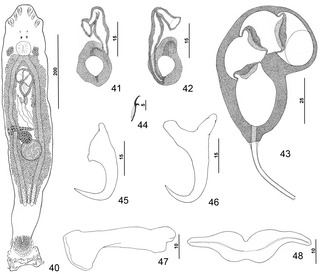
The reproductive system of gastropods varies greatly from one group to another within this very large and diverse taxonomic class of animals. Their reproductive strategies also vary greatly.

Pseudunela cornuta is a species of minute sea slug, an acochlidian, a shell-less marine and temporarily brackish gastropod mollusk in the family Pseudunelidae. Adults are about 3 mm long and live in the spaces between sand grains.

The reproductive system of planarians is broadly similar among different families, although the associated structures can vary in complexity.

Pseudorhabdosynochus manifestus is a diplectanid monogenean parasite first found in host Epinephelus malabaricus near Nouméa, between its secondary gill lamellae. It can infest its host by the hundreds. It was ascribed that name because it was the most abundant species found while its descriptive study was taking place. As appreciated from studying juvenile specimens, the development of female organs precedes that of male organs in this species and is likely the case in other Pseudorhabdosynochus species.

Pseudorhabdosynochus americanus is a diplectanid monogenean parasitic on the gills of groupers. It was described as Diplectanum americanum by Price in 1937 and transferred to the genus Pseudorhabdosynochus by Kritsky and Beverley-Burton in 1986. The species was redescribed by Kritsky, Bakenhaster and Adams in 2015.

Pseudorhabdosynochus yucatanensis is a diplectanid monogenean parasitic on the gills of the red grouper, Epinephelus morio. It was described by Vidal-Martínez, Aguirre-Macedo & Mendoza-Franco in 1997 and redescribed by Kritsky, Bakenhaster and Adams in 2015.

Pseudorhabdosynochus justinella is a diplectanid monogenean parasitic on the gills of the red grouper, Epinephelus morio. It has been described by Kritsky, Bakenhaster and Adams in 2015.

Pseudorhabdosynochus kritskyi is a diplectanid monogenean parasitic on the gills of the gag, Mycteroperca microlepis. The species has been described by Dyer, Williams and Bunkley-Williams in 1995 and redescribed successively by Yang, Gibson and Zeng in 2005 and by Kritsky, Bakenhaster and Adams in 2015. The name of the species honours the American parasitologist Delane C. Kritsky.

Pseudorhabdosynochus hyphessometochus is a diplectanid monogenean parasitic on the gills of the yellowmouth grouper, Mycteroperca interstitialis. It has been described by Kritsky, Bakenhaster and Adams in 2015.

Pseudorhabdosynochus sulamericanus is a diplectanid monogenean parasitic on the gills of the snowy grouper, Epinephelus niveatus, the Warsaw grouper, Epinephelus nigritus and the Haifa grouper, Epinephelus haifensis. It has been described by Santos, Buchmann & Gibson in 2000, redescribed by Kritsky, Bakenhaster and Adams in 2015. and again redescribed by Chaabane, Justine, Gey, Bakenhaster & Neifar in 2016.
Alloencotyllabe is a genus of parasitic monogenean in the family Capsalidae. It is monotypic, containing the sole species Alloencotyllabe caranxi. The specific epithet was derived from the type host of the species, which was fish belonging to the genus Caranx. It has been found from type specimens in the Persian Gulf.
Microcotyle brevis is a species of monogenean, parasitic on the gills of a marine fish. It belongs to the family Microcotylidae.
Microcotyle constricta is a species of monogenean, parasitic on the gills of a marine fish. It belongs to the family Microcotylidae.

Microcotyle elegans is a species of monogenean, parasitic on the gills of a marine fish. It belongs to the family Microcotylidae.
Microcotyle mouwoi is a species of monogenea, parasitic on the gills of a marine fish. It belongs to the family Microcotylidae.
Microcotyle stenotomi is a species of monogenean, parasitic on the gills of a marine fish. It belongs to the family Microcotylidae and was first described by Goto in 1899.
Microcotyle peprili is a species of monogenean, parasitic on the gills of a marine fish. It belongs to the family Microcotylidae.
Microcotyle otrynteri is a species of monogenean, parasitic on the gills of a marine fish. It belongs to the family Microcotylidae.
Microcotyle pacifica is a species of monogenean, parasitic on the gills of a marine fish. It belongs to the family Microcotylidae. It was first described an illustrated based on 31 specimens from the gills of the blackbelly eelpout Lycodes pacificus off California.

Allopseudaxine yaito is a species of monogenean flatworm, which is parasitic on the gills of a marine fish. It belongs to the family Axinidae.











